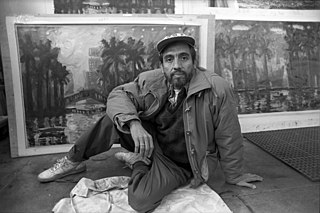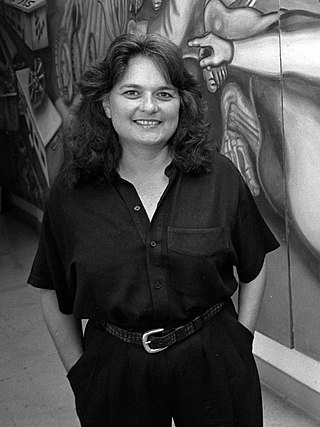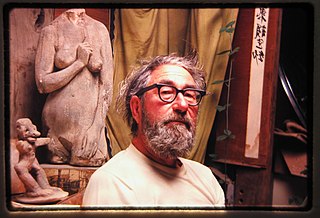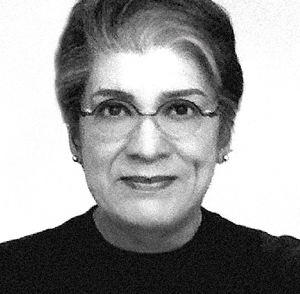Miguel Angel Reyes (born 1964) is an American artist and professor of art.
Reyes was born in Colima, Mexico in 1964. He emigrated with his family in 1975 to the United States and took up residing in Southern California. He received a BFA in illustration from the Otis Art Institute/Parsons School of Design. In 1993, he worked for a season as a jazz and modern dancer for the San Diego Dance Theater. He is openly gay. [1] [2]
In 1995, he completed a 750-foot mural, one of the largest mural projects in Los Angeles, at the corner of Hollywood Boulevard and Argyle titled Amistades (Friendships). It was commissioned by the Los Angeles County Metropolitan Transportation Authority. The mural was removed with the opening of the Hollywood segment of the Metro Red Line in 1999. [3]
Reyes has had fifteen solo exhibits and has been featured in over a hundred group shows throughout the United States, Mexico, Europe and Asia since 1989. He has also shown in major museums.
He is a portrait and figurative painter, muralist, printmaker, and illustrator.
As a regular contributor to a range of causes such as Project Angel Food, Self-Help Graphics, and Central America Resource Center (CARECEN), he not only contributes artwork but also his time and experience. [4]
He currently is instructor of model drawing in the Fashion Department of the Otis College of Art.
The culture of Los Angeles is rich with arts and ethnically diverse. The greater Los Angeles metro area has several notable art museums including the Los Angeles County Museum of Art (LACMA), the J. Paul Getty Museum on the Santa Monica Mountains overlooking the Pacific, the Museum of Contemporary Art (MOCA), and the Hammer Museum. In the 1920s and 1930s Will Durant and Ariel Durant, Arnold Schoenberg and other intellectuals were the representatives of culture, in addition to the movie writers and directors. As the city flourished financially in the middle of the 20th century, culture followed. Boosters such as Dorothy Buffum Chandler and other philanthropists raised funds for the establishment of art museums, music centers and theaters. Today, the Southland cultural scene is as complex, sophisticated and varied as any in the world.

Tyrus Wong was a Chinese-born American artist. He was a painter, animator, calligrapher, muralist, ceramicist, lithographer and kite maker, as well as a set designer and storyboard artist. One of the most-influential and celebrated Asian-American artists of the 20th century, Wong was also a film production illustrator, who worked for Disney and Warner Bros. He was a muralist for the Works Progress Administration (WPA), as well as a greeting card artist for Hallmark Cards. Most notably, he was the lead production illustrator on Disney's 1942 film Bambi, taking inspiration from Song dynasty art. He also served in the art department of many films, either as a set designer or storyboard artist, such as Rebel Without a Cause (1955), Around the World in 80 Days (1956), Rio Bravo (1959), The Music Man (1962), PT 109 (1963), The Great Race (1965), Harper (1966), The Green Berets (1968), and The Wild Bunch (1969), among others.

Kent Twitchell is an American muralist who is most active in Los Angeles. He is most famous for his larger-than-life mural portraits, often of celebrities and artists. His murals are realism not photorealism according to Twitchell.

Carlos D. Almaraz was a Mexican-American artist and a pioneer of the Chicano art movement. He was one of the founder of the Centro de Arte Público (1977–1979), a Chicano/Chicana arts organization in Highland Park, Los Angeles.

Gronk, born Glugio Nicandro, is a Chicano painter, printmaker, and performance artist. His work is collected by museums around the country including the Smithsonian American Art Museum.

Los Four was a Chicano artist collective active based in Los Angeles, California. The group was instrumental in bringing the Chicano art movement to the attention of the mainstream art world.

Werner Mathias Goeritz Brunner was a Mexican painter and sculptor of German origin. After spending much of the 1940s in North Africa and Spain, he and his wife, photographer Marianne Gast, immigrated to Mexico in 1949.

Millard Owen Sheets was an American artist, teacher, and architectural designer. He was one of the earliest of the California Scene Painting artists and helped define the art movement. Many of his large-scale building-mounted mosaics from the mid-20th century are still extant in Southern California. His paintings are in the Metropolitan Museum of Art and the Whitney Museum in New York, the Chicago Art Institute, the National Gallery in Washington D.C.; and the Los Angeles County Museum.

Carlos Mérida was a Guatemalan artist who was one of the first to fuse European modern painting to Latin American themes, especially those related to Guatemala and Mexico. He was part of the Mexican muralism movement in subject matter but less so in style, favoring a non-figurative and later geometric style rather than a figurative, narrative style. Mérida is best known for canvas and mural work, the latter including elements such as glass and ceramic mosaic on major constructions in the 1950s and 1960s. One of his major works 4000m2 on the Benito Juarez housing complex, was completely destroyed with the 1985 Mexico City earthquake, but a monument to it exists at another complex in the south of the city.

Judith Francisca Baca is an American artist, activist, and professor of Chicano studies, world arts, and cultures based at the University of California, Los Angeles. She is the co-founder and artistic director of the Social and Public Art Resource Center (SPARC) in Venice, California. Baca is the director of the mural project that created the Great Wall of Los Angeles, which was the largest known communal mural project in the world as of 2018.

Mexican muralism refers to the art project initially funded by the Mexican government in the immediate wake of the Mexican Revolution (1910-1920) to depict visions of Mexico's past, present, and future, transforming the walls of many public buildings into didactic scenes designed to reshape Mexicans' understanding of the nation's history. The murals, large artworks painted onto the walls themselves had social, political, and historical messages. Beginning in the 1920s, the muralist project was headed by a group of artists known as "The Big Three" or "The Three Greats". This group was composed of Diego Rivera, José Clemente Orozco and David Alfaro Siqueiros. Although not as prominent as the Big Three, women also created murals in Mexico. From the 1920s to the 1970s, many murals with nationalistic, social and political messages were created in many public settings such as chapels, schools, government buildings, and much more. The popularity of the Mexican muralist project started a tradition which continues to this day in Mexico; a tradition that has had a significant impact in other parts of the Americas, including the United States, where it served as inspiration for the Chicano art movement.

Federico Heraclio Cantú Garza was a Mexican painter, engraver and sculptor. While considered to be a member of the Mexican muralism movement, his style was noticeably different, mostly for adhering to older and more academic forms of painting and sculpture. He had his most success exhibiting in the United States and Europe, but he did murals and sculptures in Mexico. His best known work is a sculpture called La maternidad which was adapted as the logo of the Instituto Mexicano de Seguro Social (IMSS).

Aurora Reyes Flores was a Mexican artist, known as a painter and writer, and she was the first female muralist in Mexico and first exponent of Mexican muralism. She also went by the name Aurora Reyes.

Joseph T. Funk (c.1914–1981) was an American artist, printmaker, and educator. He was a sculptor, lithographer, and muralist. Funk worked as a master printmaker at Tamarind Lithography Workshop, Kanthos Press, and Joseph Press.

Judithe Hernández is an American artist and educator, she is known as a muralist, pastel artist, and painter. She is a pioneer of the Chicano art movement and a former member of the art collective Los Four. She is based in Los Angeles, California and previously lived in Chicago.
Willie Herrón III is an American Chicano muralist, performance artist and commercial artist.
Francisco Alonzo "Frank" Martínez was an American artist. He painted murals of his Mexican American heritage.
José Reyes Meza was a Mexican painter, costume and set designer, who helped to found a number of cultural institutions in Mexico. Reyes Meza began his artistic career principally in theater, although he was an active painter and even bullfighter in his early days. Painting became prominent starting in the 1970s, working on murals in various parts of Mexico as well as exhibiting canvas works in Mexico and abroad. The artist is a founding member of the Salón de la Plástica Mexicana and his work has been acknowledged by tributes, various awards and an art museum in Nuevo Laredo named after him.
Bernadette Vigil is an American artist and illustrator whose work has been exhibited in museums and galleries nationally and abroad. She has produced permanent public artworks in the form of fresco murals for the cities of Santa Fe and Albuquerque, New Mexico. She has been commissioned to create religious frescoes in churches in New Mexico, and has been called a "master of the art of buon fresco" in the Santos Tradition. She has authored a book on Toltec spirituality, Mastery of Awareness: Living the Agreements. In 2002 it was published in Spanish as El Dominio de la Conciencia, and in 2005 it was published in German as Das Geheimnis der vier Versprechen.